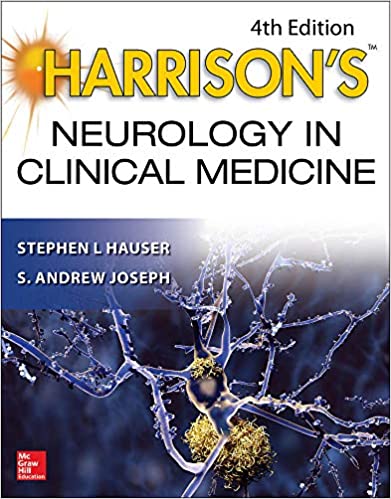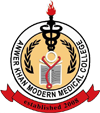Anwer Khan Modern Medical College
Library Management System

| Title: | Harrison's neurology in clinical medicine. |
| Author Name: | Stephen L. Hauser |
| Author Sur Name: | HAUSER, Stephen L. |
| Other's Author Name: | S. Andrew Josephson. |
| Author information: |
|
| Edition/Published: | 4th ed. _New York : Mc Graw Hill , 2017 |
| New to this edition: |
|
|
Physical Description: : <p>xiv, 928 pages: illustrations (black and white, and colour); 28 cm</p>.; |
| Notes | Includes bibliographical references & indexes. |
| Includes Index: | 887-928 |
| ISBN No's: | 978-1259835865 |
| Bar Code's: | |
| Shelf Location's: |
| Classification | |
| Subject: | Neurology |
| Dewey Class No: | 616.8 |
| LC Classification: | RC46 |
| Other's Book Information | |
| Book ID No: | 2647 |
| Total Books: | 1 |
| Date of collection's: | 20-Jan-2022 |
| Donation / Purchase: | Purchased |
| Language: | English |
| Status: | Available |
| Department: | Neurology and Neurosurgery |
| Synopsis: |
|
| Description: |
|
| Key Features: |
|
| Summary: |
Harrison's Neurology in cclinical medicine is a ccomprehensive and extersively updated book on the pathogenesis, diagnosis and management of neurological disorders. The book includes a conesic review of basic nuroseience as well as recent advances in the Understying of neurological diseases. It also festures new illustrations, high-yield board review questions, and self assessment \ exam review question to help readess keep current and prepase for exam . The latest 4th ed. of the book is evidence based and provides a multiawhored review of modern medicine as applied to cical neurology. |
| Abstract: |
This book is a comprehensive multiauthored textbook of neurological diaries with an emphasis on clinical management and the scientific basis of disorders with an emphasis on clinical management and the scientific basis underlying disorders. It causes a wide range of topics, including the diagnoses & treatment of neurological diseases, neuroimaging in neurological disorders, and Arrochar patients with neurological diseases. |
| Preface: |
The first three editions o Harrison’s Neurology in Clinical Medicine were unqualified successes. Readers responded enthusiastically to the convenient, attractive, expanded, and updated stand-alone volume, which was based upon the neurology and psychiatry sections from Harrison’s Principles of Internal Medicine. Our original goal was to provide, in an easy-to-use format, full coverage o the most authoritative information available anywhere o clinically important topics in neurology and psychiatry, while retaining the focus on pathophysiology and therapy that has always been characteristic o Harrison’s. T is the new fourth edition o Harrison’s Neurology in Clinical Medicine has been extensively updated to highlight recent advances in the understanding, diagnosis, treatment, and prevention o neurologic and psychiatric diseases. Readers will an expanded coverage of neurodegenerative diseases, highlighting advances in their classification and management, and delineating the new understanding o mechanisms responsible for the deposition and spread o pathogenic protein aggregates in these disorders. Neuroimmunology is another dynamic and rapidly changing eld o neurology, and the new edition o Harrison’s provides extensive coverage o progress in this area, including a timely summary o advances in understanding paraneoplastic syndromes, autoimmune encephalitis, and neuromyelitis optica, as well as a practical guide to navigating the large number o treatment options now available or multiple sclerosis. T e chapter on cerebrovascular diseases has also been extensively revised to reflect the exciting new opportunities for acute treatment and prevention o ischemic and hemorrhagic stroke. Sleep disorders and migraine are additional areas in which important advances are highlighted in the new edition. Many illustrative neuroimaging figures appear throughout the section, and an updated and expanded atlas o neuroimaging findings is also included. We have been extremely pleased with the warm reception that greeted the high-definition video presentations introduced in the last edition o Harrison’s, and in the fourth edition, we have added to the collection new videos illustrating sleep disorders and examination o the comatose patient. For many physicians, neurologic diseases represent particularly challenging problems. Acquisition of the requisite clinical skills is often viewed as time-consuming, difficult to master, and requiring a working knowledge of obscure anatomic acts and laundry lists o diagnostic possibilities. T e patients themselves may be dif cult, as o neurologic medicine in Harrison’s befitting its critical role in the practice of internal medicine. T e editors are indebted to our authors, a group of internationally recognized authorities who have magnificently distilled a daunting body of information into the essential principles required to understand and manage commonly encountered neurologic problems. T anks also to Dr. Elizabeth Robbins who has served for more than 20 years as managing editor o the neurology section o Harrison’s; she has overseen the complex logistics required to produce a multiauthored textbook and has promoted exceptional standards of clarity, language, and style. Finally, we wish to acknowledge and express our great appreciation to our colleagues at McGraw-Hill. T is new volume was championed by James Shanahan and impeccably managed by Kim Davis. We live in an electronic, wireless age. Information is downloaded rather than pulled from the shelf. Some have questioned the value o traditional books in this new era. We believe that as the volume of information, and the ways to access this information, continue to grow, the need to grasp the essential concepts of medical neurologic disorders often alters an individual’s capacity to recount the history o an illness or to even recognize that something is wrong. An additional obstacle is the development of independent neurology services, departments, and training programs at many medical centers, reducing the exposure o trainees in internal medicine to neurologic problems. All of these forces, acting within the fast-paced environment of modern medical practice, can lead to an overreliance on unfocused neuroimaging tests, suboptimal patient care, and unfortunate outcomes. Because neurologists represent less than 1% o all physicians, the vast majority of neurologic care must be delivered by nonspecialists who are often generalists and usually internists. T e old adage that neurologists “know everything but do nothing” has been rendered obsolete by advances in molecular medicine, imaging, bioengineering, and clinical research. Examples o new therapies include intravenous and endovascular recanalization in acute ischemic stroke, intensive monitoring of brain pressure and cerebral blood flow for brain injury, effective therapies or immune-mediated neurologic disorders, new designer drugs or migraine, the first generation of rational therapies or neurodegenerative diseases, neural stimulators or Parkinson’s disease, drugs or narcolepsy and other sleep disorders, and control of epilepsy by surgical resection o small seizure foci precisely localized by functional imaging and electrophysiology. T e pipeline continues to grow, stimulated by a quickening tempo o discoveries generating opportunities or rational design o new diagnostics, interventions, and drugs. T e founding editors o Harrison’s Principles of Internal Medicine acknowledged the importance o neurology but were uncertain as to its proper role in a textbook o internal medicine. An initial plan to exclude neurology from the first edition (1950) was reversed at the eleventh hour, and a neurology section was hastily prepared by Houston Merritt. By the second edition, the section was considerably enlarged by Raymond D. Adams, whose influence on the textbook was profound. T e third neurology editor, Joseph B. Martin, brilliantly led the book during the 1980s and 1990s as neurology was transformed from a largely descriptive discipline to one of the most dynamic and rapidly evolving areas of medicine. With these changes, the growth of neurology coverage in Harrison’s became so pronounced that Harrison suggested the book be retitled, T e Details of Neurology and Some Principles of Internal Medicine. His humorous comment, now legendary, underscores the depth of coverage practice becomes even more challenging. One of our young colleagues recently remarked that he uses the Internet to find facts, but that he reads Harrison’s to learn medicine. Our aim has always been to provide the reader with an integrated, organic summary o the science and the practice of medicine rather than a mere compendium of chapters, and we are delighted and humbled by the continuing and quite remarkable growth in popularity of Harrison’s at a time when many “classics” in medicine ears past. We are of course cognizant of the flexibility in information delivery that today’s readers seek, and so we have also made the fourth edition o Harrison’s Neurology in Clinical Medicine available in a number of eBook formats or all major devices, including the iPad (available via the iBookstore). It is our sincere hope that you will enjoy using Harrison’s Neurology in Clinical Medicine, Fourth Edition, as an authoritative source for the most up-to-date information in clinical neurology. |
| Content: |
Contributors . . . . . . . . . . . . . . . . . . . . . . . . . . . . . . . . . . .ix |
